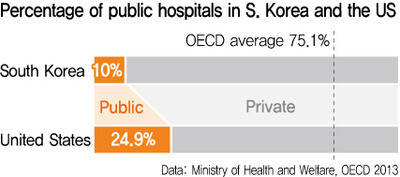hankyoreh
Links to other country sites 다른 나라 사이트 링크
Profit-oriented healthcare leads to preventable deaths

By Kim Yang-joong, medical correspondent
In early April, a 48-year-old man surnamed Seo died of tuberculous pleurisy in a nursing home in Goyang, Gyeonggi Province. He had been diagnosed with tuberculosis at the hospital at the beginning of Jan. 2014, but the nursing home was not capable of treating pleurisy, which involves inserting a tube into the chest cavity (where the heart and lungs are located) to siphon out pus.
The nursing home was not able to send him to a general hospital, either. Seo was a recipient of the basic livelihood assistance. He had no one to look after him, and no money.
At last, a social welfare worker at the nursing home filed a request for emergency medical assistance with Goyang City and used the funds to transfer Seo to a general hospital. But after 50 days at the bigger hospital, Seo was discharged because of 6 million won (US$5,850) in hospital bills. A few days after returning to the convalescent hospital, he breathed his last.
“If he had died of an untreatable disease, I probably wouldn’t feel so frustrated about it. The patient had pleurisy, which is completely treatable. In the end, he died because he didn’t have any money. Surely the hospital’s profit isn’t more important than people’s lives,” a doctor working at the nursing home said on May 20.
Prioritizing money over human lives, a tendency that was made abundantly clear in the tragic sinking of the Sewol ferry, is also found in the medical world, which deals directly with human lives.
In South Korea, people boast about the top-of-the-line university hospitals and world-class treatments available there, but it has long been the case that these are only provided to those who can afford them. The medical treatment that is supposed to protect the public’s health and the public’s lives has been entrusted to private hospitals that prioritize their bottom line.
90% of hospitals in South Korea are privately run, the highest percentage in the world. It is higher than the OECD average of 28%; it even surpasses the percentage of 75% in the US, which is well known for the dominance of private medical care.
Privately run hospitals must survive against intense competition, and they are operated in pursuit of revenue in order to maximize their profits. Nurses are needed to take care of patients, but hospitals hire fewer of them because they do not increase revenue. Hospitals also import high-priced diagnostic and operating equipment and urge patients to have expensive tests.
According to OECD.StatExtracts, in 2011 the number of registered nurses per 1,000 people in South Korea is only 2.39, the lowest figure among the 23 OECD member countries. In contrast, 2012 statistics show that there are 23.46 MRI units per 1 million people in South Korea. MRI tests are hardly ever covered by insurance.
During every election, presidential candidates promise to expand public health care, including medical facilities in the provinces, but these pledges have not been kept. Even worse, the administration of President Park Geun-hye has permitted long-distance medical treatment and allows hospitals to set up for-profit affiliates, policies that could accelerate the commercialization of the medical industry.
“The emphasis on profits and disregard of safety resulted in the Sewol tragedy,” said Woo Seok-gyun, chair of the policy board for the Korean Federation Medical Activist Groups for Health Rights. “If [the government] maintains its policy of commercializing the medical industry by allowing hospitals, which have already been dashing after more profits, to run additional for-profit businesses through affiliate companies, the medical costs of patients will go up, and patients’ safety will be jeopardized even further.”
Please direct questions or comments to [english@hani.co.kr]

Editorial・opinion
![[Column] Season 2 of special prosecutor probe may be coming to Korea soon [Column] Season 2 of special prosecutor probe may be coming to Korea soon](https://flexible.img.hani.co.kr/flexible/normal/500/300/imgdb/original/2024/0426/3317141030699447.jpg) [Column] Season 2 of special prosecutor probe may be coming to Korea soon
[Column] Season 2 of special prosecutor probe may be coming to Korea soon![[Column] Park Geun-hye déjà vu in Yoon Suk-yeol [Column] Park Geun-hye déjà vu in Yoon Suk-yeol](https://flexible.img.hani.co.kr/flexible/normal/500/300/imgdb/original/2024/0424/651713945113788.jpg) [Column] Park Geun-hye déjà vu in Yoon Suk-yeol
[Column] Park Geun-hye déjà vu in Yoon Suk-yeol- [Editorial] New weight of N. Korea’s nuclear threats makes dialogue all the more urgent
- [Guest essay] The real reason Korea’s new right wants to dub Rhee a founding father
- [Column] ‘Choson’: Is it time we start referring to N. Korea in its own terms?
- [Editorial] Japan’s rewriting of history with Korea has gone too far
- [Column] The president’s questionable capacity for dialogue
- [Column] Are chaebol firms just pizza pies for families to divvy up as they please?
- [Column] Has Korea, too, crossed the Rubicon on China?
- [Correspondent’s column] In Japan’s alliance with US, echoes of its past alliances with UK
Most viewed articles
- 1[Column] Season 2 of special prosecutor probe may be coming to Korea soon
- 2‘We must say no’: Seoul defense chief on Korean, USFK involvement in hypothetical Taiwan crisis
- 3Is N. Korea threatening to test nukes in response to possible new US-led sanctions body?
- 4No good, very bad game for Korea puts it out of Olympics for first time since 1988
- 5Is Japan about to snatch control of Line messenger from Korea’s Naver?
- 6Division commander ordered troops to enter raging flood waters before Marine died, survivor says
- 7Korea’s 1.3% growth in Q1 signals ‘textbook’ return to growth, says government
- 8N. Korean delegation’s trip to Iran shows how Pyongyang is leveraging ties with Moscow
- 9[Editorial] Korea’s surprise Q1 growth requires objective assessment, not blind fanfare
- 10[Editorial] Government needs to stop impeding Sewol mourning